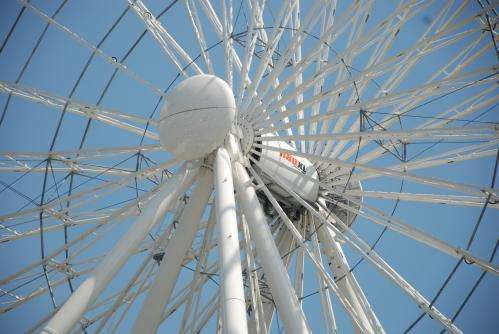High-tech for huge, mobile ferris wheels

The world's largest transportable Ferris wheel is equipped with control and drive technology from Siemens. The 750-ton, 80-meter tall steel giant was built by the Munich-based company Maurer German Wheels according to a plan by Bussink Design. The 74-meter wide wheel rotates two to four times per hour and can carry up to 16 passengers in each of its 27 gondolas. While a second R80XL-type Ferris wheel is being prepared in Munich, the first is already spinning in Mexico. Siemens supplied the drive systems, electronics, and automation technology that ensure the wheel's efficient operation and, most importantly, guarantee a safe ride.
Mobile XL Ferris wheels are not designed for county fairs, as they take three to four weeks to construct and disassemble. Instead, the giant rides serve as temporary tourist attractions at alternating locations. For example, the first of the two record-breaking Ferris wheels has been attracting visitors to Puebla, Mexico, since the summer of 2013. Safety is the top priority in such huge rides, which have two systems to handle power outages, for example. Besides boasting an emergency power generator, the Ferris wheel has excellent bearings that ensure its center of gravity always rolls downward so that all of the passengers can be evacuated even if there is no electricity.
High safety and efficiency; optimal weight distribution
Safety is also ensured by two redundant Simatic S7-300F controls from Siemens that are certified to be failsafe. All of the switching technology is distributed in two redundant containers at separate locations. The controls operate the drive motors as well as the gondola infrastructure, which includes the lighting, the air conditioning, and the power doors.
The drives consist of eight electric motors with rubber tires that rotate the big wheel by pressing on various parts of its exterior. Automatic setting systems continually adjust the pressure that is exerted on the wheel to ensure it is always at an optimal level. Each motor is equipped with a frequency converter that optimally adjusts the rotational speed in order to reduce wear and tear. The motors' condition is continually monitored as well. The converters allow the braking energy to be fed back into the local grid. Because all of the drive system components are coordinated with one another, the wheel can be operated in a way that optimizes efficiency and keeps wear to a minimum.
The entry of the passengers is also automated. All of the gondolas provide the operator with information on their status through a robust industrial wireless LAN connection. On the basis of ticket sales, the operator also knows how many passengers are waiting to get on the Ferris wheel. The passengers are automatically allowed into the gondolas in such a way that the weight is always optimally distributed around the wheel.
Provided by Siemens



















